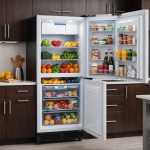Kitchen Layout Design for Efficiency
When designing a kitchen layout, the key to success lies in workflow optimization. An efficient design streamlines activities, enhancing productivity, whether you’re a professional chef or a home cook. Achieving such optimization requires careful consideration of layout options such as U-shaped, L-shaped, or galley designs, each offering unique benefits tailored to specific needs.
Importance of an Efficient Kitchen Layout
An efficient kitchen layout minimizes unnecessary movement between workstations, facilitating a smooth cooking process. This reduces errors and speed-ups meal preparation. Effective designs ensure all tools and appliances are within easy reach, supporting a seamless workflow.
Also to see : Harmonize Your Cooking Spaces: Cutting-Edge Tips to Unite Indoor and Outdoor Kitchens
Recommended Kitchen Layouts
Types of kitchen layouts to consider include:
- U-shaped: Ideal for larger spaces, enabling multiple workstations.
- L-shaped: Great for smaller areas, offering two open walls for flexibility.
- Galley: Maximizes narrow spaces, with parallel counters for compact efficiency.
Strategic Placement of Workstations
Strategically placing workstations is crucial in efficient design. The concept of the “work triangle,” connecting the stove, sink, and refrigerator, is a proven solution for maximum productivity. This approach reduces congestion and optimizes movement, ensuring a well-coordinated and proficient kitchen flow.
Have you seen this : Revamp Your Kitchen Safety: Unleash Innovative IoT Solutions for a Secure Culinary Adventure
Essential Equipment and Tools for Culinary Success
To achieve culinary excellence, investing in the right kitchen equipment and tools is paramount. Optimising tools doesn’t just boost cooking efficiency but also elevates the quality of meals, ensuring a professional standard in home kitchens.
Must-Have Appliances
Begin with essential appliances like a high-quality blender, versatile microwave oven, and a functional gas or electric stove. These foundational items provide a solid starting point for a comprehensive kitchen setup. Incorporate a cutting-edge food processor to simplify complex tasks, reducing preparation time significantly.
Enhancing Cooking Efficiency and Quality
Invest in durable culinary tools such as sharp knives of various sizes, precision measuring cups, and multifunctional peelers. High-quality pots and pans with non-stick coatings are invaluable for efficient, mess-free cooking. Consider adding a slow cooker or sous-vide machine for advanced techniques that enhance the culinary repertoire, introducing nuances in flavours and textures.
Budgeting for Equipment
While establishing a budget is crucial, do not compromise on the quality of essential tools. Look for deals or second-hand options from reputable brands to maximise your investment. This thoughtful approach ensures a balance between cost and performance, fostering culinary creativity without financial strain.
Creative and Functional Storage Solutions
An efficient kitchen storage system boosts organization and enhances productivity. Innovative storage ideas help maintain order, even in the busiest kitchens. For instance, introducing pull-out shelves and rotating racks can transform unused corners into accessible, functional spaces.
Utilizing Vertical Space and Hidden Storage Solutions
Maximizing vertical space is a game-changer in kitchen organization. Installing tall cabinets or adding overhead racks provides storage without occupying floor space. Additionally, hidden storage solutions like fold-down spice racks or toe-kick drawers are effective for minimizing clutter while keeping essentials close.
Tips for Keeping Frequently Used Items Easily Accessible
Keeping frequently used items accessible is crucial in an active kitchen. Designate specific drawers or open shelves for frequently used utensils and tools. This strategy ensures that essential items are always within reach, reducing the time spent searching. Another tip is to use clear containers for pantry items, allowing for a quick visual check of supplies.
Overall, these strategies not only maintain cleanliness but also streamline your cooking experience, fostering a seamless workflow. Efficient storage solutions make daily kitchen activities smoother and more enjoyable, transforming any kitchen space into a hub of culinary creativity.
Safety Regulations and Compliance
Ensuring compliance with food safety regulations is crucial in maintaining a safe and hygienic kitchen environment. Strict adherence to these regulations not only protects consumers but also sustains your culinary business’s reputation. Compliance begins with understanding the kitchen regulations that govern safe food handling, including appropriate temperature control and cross-contamination prevention.
Importance of Cleanliness and Sanitation Practices
Maintaining a high level of cleanliness within the kitchen is mandatory to meet health codes. Frequent sanitisation of work surfaces and utensils is vital in preventing foodborne illnesses. Proper handwashing techniques and routine cleaning schedules further promote a safe cooking environment, safeguarding both staff and patrons.
Complying with Local Health Codes and Permits
Navigating local health codes and securing necessary permits are foundational steps for any culinary business. Familiarise yourself with the specific requirements in your area, as these can vary significantly. Attend workshops or consult with health inspectors to ensure everything from ventilation systems to waste disposal meets the regulatory standards. By prioritising food safety and staying informed, kitchen owners can avoid fines and build consumer trust.
These practices not only ensure compliance but also contribute to a healthier, more reliable kitchen operation.
Understanding Zoning Laws for Home-Based Businesses
Starting a home-based business in the culinary field demands an understanding of zoning laws. These regulations, dictated by local government, specify how a property can be used. Failing to comply can lead to hefty fines or shutdowns.
Zoning laws often distinguish between residential and commercial operations, impacting the possibility of running a culinary business from home. It’s crucial to research how these laws apply within your locality. Seek information from your local zoning office or consult municipal websites to understand permitted business activities in your area.
Applying for the necessary permits is the next step for ensuring regulatory compliance. This process usually involves explaining the nature of your business, anticipated foot traffic, and any potential environmental impacts. Obtaining these permits legitimizes your operation and protects against legal repercussions.
Non-compliance with zoning regulations can result in severe consequences, including penalties and business closure. Always monitor changes in local laws to maintain compliance. Staying informed and proactive not only secures your business but also builds trust within the community. It ensures your culinary idea flourishes legally and sustainably, fostering both creativity and integrity in your home-based enterprise.
Creating an Inviting Culinary Atmosphere
Designing an inviting kitchen atmosphere significantly enhances the culinary experience, transforming cooking spaces into warm, welcoming environments. A well-thought-out inviting design not only improves functionality but also adds to the kitchen’s aesthetic appeal.
Tips for Designing a Warm and Inviting Kitchen Space
Crafting a cosy kitchen begins with choosing the right colour palette. Soft, neutral tones create a soothing backdrop, while vibrant accents add personality and energy. Good lighting is crucial; integrate both natural light and ambient fixtures to highlight the kitchen’s best features.
Importance of Aesthetics in Attracting Customers
An attractive kitchen can draw customers to culinary businesses. The design should reflect not just taste, but also professionalism and cleanliness. Incorporating elegant countertops and stylish backsplashes can enhance the overall appeal, making the space not only functional but visually engaging.
Incorporating Personal Touches That Reflect Culinary Style
Infuse the kitchen with personal touches that showcase your culinary style. Display unique utensils or vintage cookware to add character. Custom artwork or themed decorations can serve as conversation starters, making your kitchen a memorable place for both cooking and entertaining. Such details don’t just personalize the space — they elevate it.
Case Studies of Successful Home-Based Kitchens
Exploring successful home-based kitchens can serve as an inspiration for culinary entrepreneurs. Through real-life examples, we can understand the importance of space management and strategic equipment selection.
Example 1: Small Space Optimization
Jane, a successful pastry chef, transformed her compact kitchen into an efficient workspace by prioritizing vertical storage solutions. She installed shelves and overhead racks, allowing her to utilize previously neglected spaces. This practice not only provided additional storage but kept her frequently used culinary tools within reach, enhancing workflow optimization.
Example 2: Equipment Selection That Makes a Difference
Digital scales and immersion blenders were key tools for Michael, a home-based chef specializing in sauces. These essential appliances allowed for precise measurements and consistency in his recipes, elevating quality. By focusing on versatile and high-quality tools, Michael optimized his kitchen efficiency without overwhelming the workspace.
Example 3: Effective Organization Strategies
Sarah’s food prepping business thrived due to her keen eye for organization. By employing clear kitchen storage bins and labelling systems, she minimized chaos. Designating specific zones for different tasks ensured efficient design, improving her daily operations. These examples showcase how smart choices can make even limited spaces thrive in the culinary business landscape.


